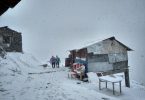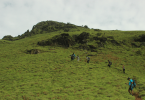Acute Mountain sickness or AMS is one of the most common forms of Altitude sickness. It is also the mildest form of altitude sickness but still manages to dampen the excitement of your trekking journey or even when you’re traveling to high altitude regions like Ladakh or Spiti. But what exactly is AMS and how do you prepare for it?
Acute Mountain Sickness – What is it?
Most of us live on plain regions and hence our bodies get plenty of oxygen from the air but when it comes to high altitude regions, it’s a different case. Anywhere between 8,000ft to 12,000ft above sea level is considered a high altitude. When you move to high altitude regions, the air pressure changes and the oxygen level decreases. Since your body’s demand of oxygen isn’t being fulfilled and you’re constantly on the move, your body reacts poorly and it’s an uncomfortable process. You start to feel lightheaded, nauseous and even develop a headache. This is exactly what Acute Mountain Sickness is and it goes away if you return to a lower elevation but in order to do that, you need to know that you’ve been hit by AMS and that can only happen if you’re aware of the symptoms.
What are the symptoms of Acute Mountain Sickness?
As mentioned above, there are a certain symptoms of AMS that you need to look out for and though the symptoms can vary from one individual to another but the most common ones that we see are
- Headache
- Nausea and vomiting
- Dizziness
- Sleeplessness
- Uneasiness
- Breathlessness
- Loss of appetite
- Increased urge to pee
- Faster heartbeat
Even if you experience only one or two of the above listed symptoms, it’s important that you seek help. AMS can be avoided by taking simple measures and it’s crucial that it gets treated in its initial stage because the more time you spend avoiding medical aid, the more nasty the situation becomes.
How to prevent Acute Mountain Sickness ?
There are some precautionary measures you can take while trekking or traveling to high-altitude regions to decrease your chances of developing AMS or avoid any severe symptoms.
- Acclimatization: It is crucial to add a buffer day when you’re moving to a high altitude region especially if you are in a vehicle. It gives your body the time and rest it needs to get adapted to the harsh weather conditions and gain in altitude. This becomes even more important if you’re traveling to northern regions by flight because then you gain a considerable elevation in just a matter of few hours which is bound to make you sick. Also, make sure to spend your night at the nearest low altitude spot if possible because as the temperature falls at night the risk of AMS increases.
- Maintain Body Temperature: This is important because the temperature drops considerably when you move to higher regions and if you are unable to maintain your normal body temperature, then your chances of developing AMS will increase as well. It is advised that you keep your body as warm as possible and wear at least three to four layers of warm clothing.
- Eat Regularly: One of the symptoms of AMS is feeling exhausted. This is because we tend to eat less food while we are traveling, and even if we do, it is not nutritious which makes our stomach feel heavy. Untimely and unhealthy food should be avoided at all times. Timely consumption of food gives your body the energy it requires and also assists in maintaining body temperature when the diet is appropriate. You should opt for hot soup, eggs, energy bars and other foods that are light to consume.
- Stay Hydrated: The easiest and often the most ignored way of avoiding AMS is to drink plenty of water. It is a known fact that drinking water helps our bodies to maintain the oxygen level in our blood cells and since AMS is caused due to lack of oxygen, the obvious choice to prevent it is to stay hydrated. You must drink water at short intervals of time and avoid caffeine as much as possible.
- Ascend Gradually: One of the many reasons why our body reacts poorly to the sudden gain in altitude is because it doesn’t get time to adapt to the surroundings. This is something that can be avoided if you plan your itinerary after being mindful of the fact that you need to ascend gradually and there shouldn’t be a rush when it comes to moving ahead.
How to act when AMS hits?
Staying hydrated and taking proper rest in between can help prevent AMS but even if you drink plenty of water, your body can still react poorly to the conditions.
The most obvious response when AMS hits is to descend as soon as possible. There are many reasons why you must descend quickly. The biggest reason is that the more time you spend without treating your condition, the worse it gets. Getting to a lower altitude will slowly start to make you feel better and you will be able to avoid any chance of your condition worsening. However in case, the descent isn’t possible due to reasons such as the trail being one that compels you to complete the circuit and doesn’t allow you to head back, or even if it’s simply nighttime, then a 250mg dose of Diamox with water followed by rest would be advised to help you feel better until we can descend.
Besides all the above, it is important to note that you must reach out to someone if you are experiencing symptoms of AMS instead of brushing them off. Listen to your body!
Now that you know what AMS is, all you need to know is how you can prepare your body and mind before a trek or a trip.







